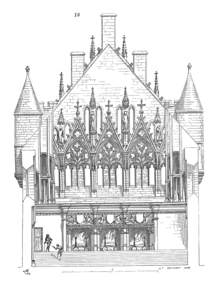Guy de Dammartin
Guy de Dammartin , also written Gui , Guiot , Guyot or Guillot and Dampmartin , (* 1340/1345; † 1398 ) was a French architect and sculptor of the Middle Ages . He built the ducal palaces of Poitiers and Bourges and founded the late Gothic French flamboyant style around 1380 .
Life
It is believed that Guy de Dammartin was the brother of Drouet de Dammartin († February 1413), architect of Philip the Bold . He worked under the direction of his teacher, the royal Parisian architect Raymond du Temple , at the same time as his brother in the Louvre . There he worked as a sculptor from 1362 to 1365 and, in the course of the embellishment ordered by King Charles V , created the statues of the Dukes of Berry and Burgundy for the famous grande vis spiral staircase together with Jacques de Chartres . During this time, he worked on the decor of the ceiling with Jean de Saint-Romain .
Shortly before 1370, Guy de Dammartin joined Duke Jean de Valois as construction manager . Dammartin oversaw all of the Duke's construction projects. In 1367 he began redesigning Mehun-sur-Yèvre Castle , and in 1374 he restored Lusignan Castle . In the years between 1380 and 1389 he redesigned the castle in Riom and built the Sainte-Chapelle there. From 1382 to 1388 he carried out the renovation of the ducal palace in Bourges, including the Sainte-Chapelle.
The artist's genius manifested itself in the French style of flamboyant he created, which he gave shape to arches, ceilings and windows. At the end of the 1380s he restored the early Gothic palace of the former dukes of Aquitaine (today's Palace of Justice) in Poitiers . The showpiece is the multi-level chimney wall, which closes the narrow side of the large hall like a theater backdrop, and the upper part of which is taken up by tracery windows and eyelashes . Within secular architecture, it is considered to be excellent evidence of the Flamboyant style, which was to be decisive in France for more than a century.
literature
- Camille Enlart : Dammartin (Dampmartin), Guy or Guyot de . In: Ulrich Thieme (Hrsg.): General Lexicon of Fine Artists from Antiquity to the Present . Founded by Ulrich Thieme and Felix Becker . tape 8 : Coutan-Delattre . EA Seemann, Leipzig 1912, p. 326–327 ( Text Archive - Internet Archive ).
- Jacques Soyer: Documents inédits sur le séjour et la demeure à Bourges de divers artistes au service de Jean de France, duc de Berry et d'Auvergne, comte de Poitou. In: Mémoires de la Société des antiquaires du Center. No. 27, 1903, ISSN 0755-2092 , pp. 305-328 ( gallica.bnf.fr ).
- Rolf Toman (Ed.): Gotik. Könemann, Cologne 1998, ISBN 3-89508-313-5 , p. 167.
- Dictionnaire des architectes. Albin Michel, Paris 1999, ISBN 2-226-10952-8 .
- Stephen Murray: Dammartin, de (1) Guy [Guillot; Guyot] de Dammartin, (2) Drouet [Dreux] de Dammartin . In: Colum P. Hourihane (Ed.): The Grove Encyclopedia of Medieval Art and Architecture . tape 2 : Cefalù to Giotto . Oxford University Press, Oxford 2012, ISBN 978-0-19-539536-5 , pp. 254–255 , doi : 10.1093 / gao / 9781884446054.article.T021277 (English, books.google.de ).
Web links
- Guy de Dammartin. In: Structurae (French)
Individual evidence
- ^ Camille Enlart: Dammartin (Dampmartin), Dreux or Drouet (André) de . In: Ulrich Thieme (Hrsg.): General Lexicon of Fine Artists from Antiquity to the Present . Founded by Ulrich Thieme and Felix Becker . tape 8 : Coutan-Delattre . EA Seemann, Leipzig 1912, p. 326 ( Textarchiv - Internet Archive ).
- ^ Georg Zarnecki, Florens Deuchler, Irmgard Hutter: Neue Belser Stilgeschichte. Volume 4: Romanesque, Gothic, Byzantium. Chr.Belser AG, Stuttgart / Zurich 1986, ISBN 3-7630-1970-7 , p. 248.
| personal data | |
|---|---|
| SURNAME | Dammartin, Guy de |
| ALTERNATIVE NAMES | Dammartin, Guiot de; Dammartin, Guyot de; Dammartin, Guillot de; Dampmartin, Guy de; Dampmartin, Guiot de; Dampmartin, Guyot de; Dampmartin, Guillot de |
| BRIEF DESCRIPTION | French architect and sculptor |
| DATE OF BIRTH | between 1340 and 1345 |
| DATE OF DEATH | 1398 |
